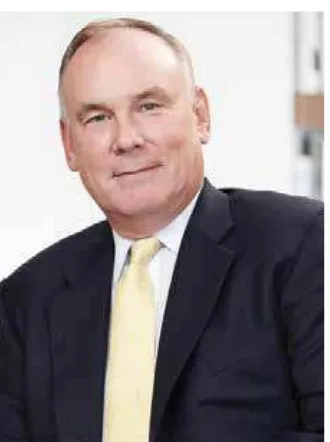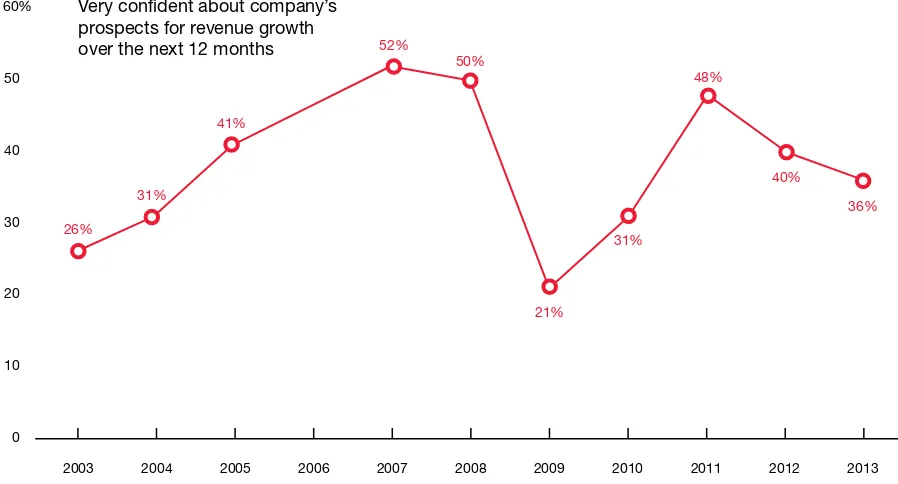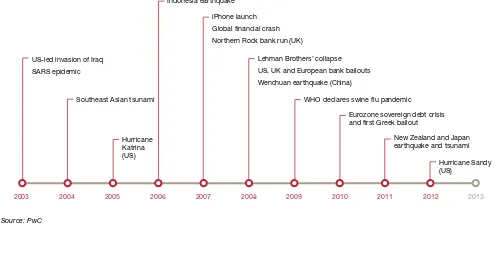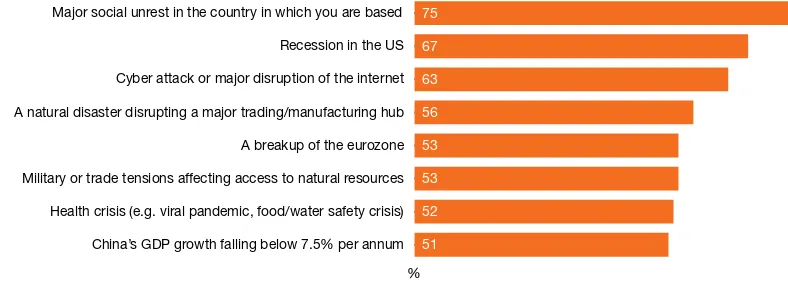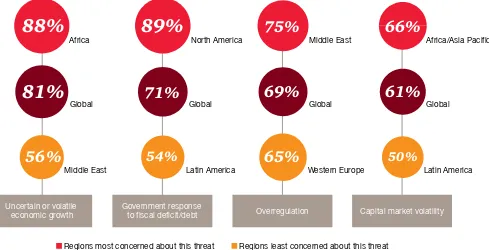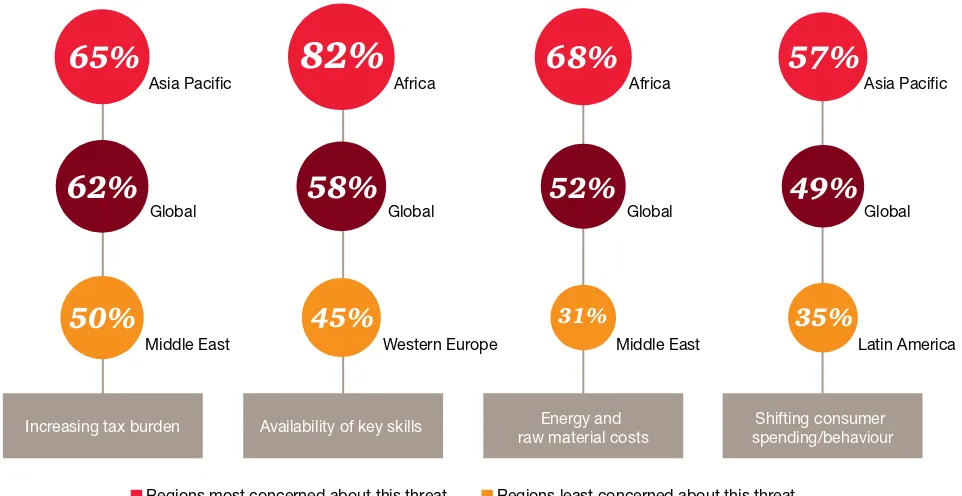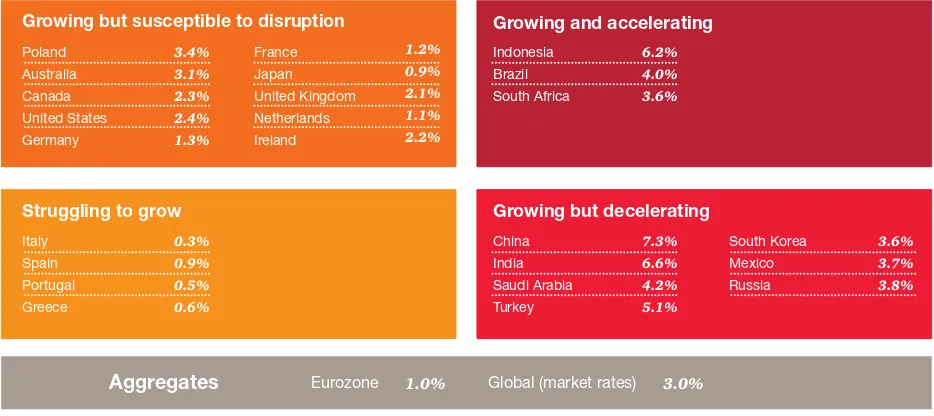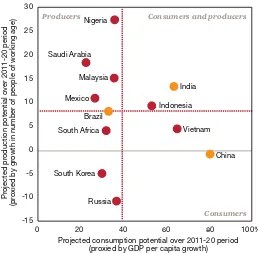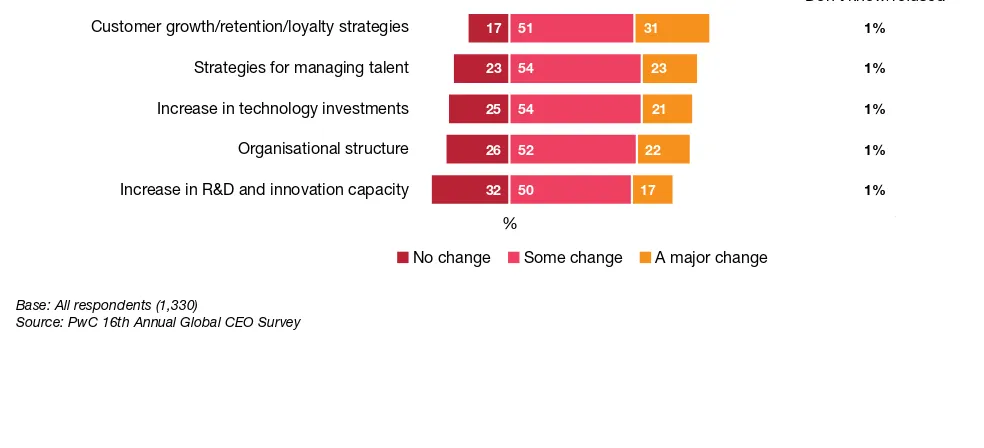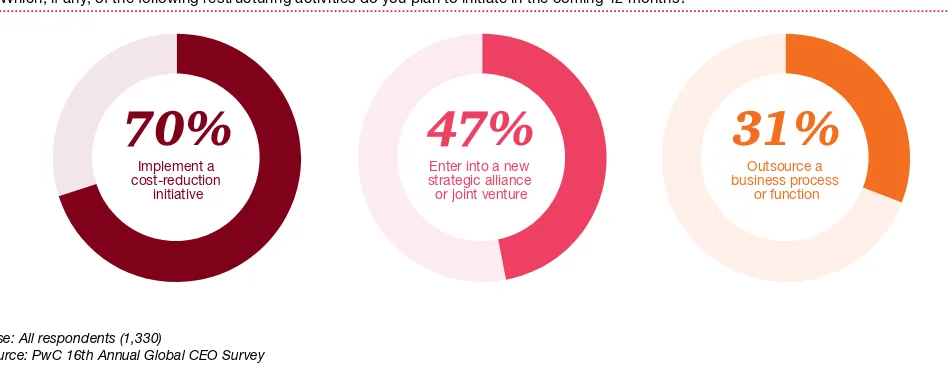www.pwc.com/ceosurvey
Dealing with
disruption
Adapting to survive
and thrive
16th Annual Global CEO Survey
The disruptive decade
p3/ What worries CEOs most?
p5/ A three-pronged
approach
p10/ It’s a question of trust
p221,330
CEOs in 68 countries36%
of CEOs are very conident about their growth prospectsSee page 3
Preface
During the past decade, we’ve seen economic volatility and disruption escalate to arguably unprecedented levels. In a globalised world – one where countries, economies and companies are more interconnected and interdependent than ever before – risks that once seemed improbable and even remote have become the norm. For business leaders across the world, ‘expect the unexpected’ has become the mantra.
To navigate through this environment, companies need to develop resilience. This combines an ability to ride out the immediate impact of shocks with a long-term capacity to adapt to constantly changing conditions. We’re helping more and more of our clients achieve this blend of qualities not only to survive through new and emerging challenges, but to thrive in this environment.
In my view, the shift to resilience helps to explain the widening gap between CEOs’ levels of conidence in their organisations’ one-year and three-year outlooks. This year’s survey shows that just 36% of CEOs are ‘very conident’ about their business’s growth prospects over the next 12 months, down from 40% in 2012 and 48% in 2011 (see Figure 1). In contrast, the proportion conident about growth over the coming three years has held up much better. This suggests that leaders believe their organisations can be resilient by rolling with the short-term blows while reshaping for longer-term growth.
What strategies are CEOs adopting to become more resilient? Our indings highlight three common approaches. First, they’re targeting speciic pockets of opportunity for organic growth, avoiding spreading their resources too thinly. Second, they’re maintaining a clear focus on the customer, taking active steps to stimulate demand, loyalty and innovation in their customer base – through mechanisms ranging from digital marketing platforms to collaborative R&D. And third, they’re ine-tuning their operational effectiveness by reducing costs without cutting value and collaborating with trusted partners.
The focus on trust also goes much further. In the post-crisis world, trust is at a premium. But it’s also an essential component of the ongoing relationship between an organisation and all its stakeholders – and thereby an important pillar of resilience. With social media giving a voice to evermore diverse groups of stakeholders, CEOs are recognising the need to secure a stronger social mandate by rebuilding public trust. From promoting an ethical culture to increasing workforce diversity and reducing environmental impacts, they’re pursuing a wide array of initiatives to simultaneously support their growth strategies, establish the right mandate and boost resilience.
My sincere thanks go to the more than 1,300 CEOs from 68 countries who shared their thinking with us. Their active and candid participation is the single greatest factor in the success of the PwC Annual Global CEO Survey, now in its 16th year. We greatly appreciate our respondents’ willingness – indeed eagerness – to free up their valuable time to help make this survey as comprehensive as possible. I’m especially grateful to the 33 CEOs who sat down with us in late 2012 to hold deeper and more detailed conversations. You can see their verbatim comments throughout this report.
Dennis M. Nally
Contents
The disruptive decade
3
What worries CEOs most?
5
A three-pronged approach
10
Targeting pockets of opportunity 10
Concentrating on the customer 14
Improving operational effectiveness 18
It’s a question of trust
22
CEO survey participants
28
I think the level of external threats has increased with every
passing decade. And as the pace of change has increased,
organisations like ours have to be a lot more lexible than
we might have been in the past.
The disruptive decade
The global economic outlook is certainly enough to test even the strongest enterprises. The eurozone is still mired in recession and the US economy is forecast to expand by just 2.2% this year.1 The situation in some of the growth markets is also getting harder, as the slowdown in the BRIC economies demonstrates.
While market conditions in many countries are still very dificult, CEOs are more positive about the prognosis than they were last year: 52% think the
Figure 1: CEO confidence has gone up and down sharply over the past decade
Q: How confident are you about your company’s prospects for revenue growth over the next 12 months?
Very confident about company’s prospects for revenue growth over the next 12 months
0 10 20 30 40 50 60%
2013 2011
2010 2009
2008 2007
2003 2004 2005 2006 2012
40% 48%
52%
26%
31%
41%
50%
21%
36%
31%
Base: All respondents (2013=1,330; 2012=1,258; 2011=1,201; 2010=1,198; 2009=1,124; 2008=1,150; 2007=1,084; 2006 (not asked); 2005=1,324; 2004=1,386; 2003=989)
Source: PwC 16th Annual Global CEO Survey
global economy will stay the same for the next 12 months and only 28% believe it will shrink. In 2012, by contrast, 48% were convinced the global economy would contract.
But economic plateaux aren’t exactly grounds for cheer. That’s why short-term conidence about the prospects for revenue growth has continued falling (see Figure 1). CEOs in Western Europe are especially nervous. Only 22% feel very conident they can increase their company’s revenues in the coming 12 months, compared with 53% of CEOs in the Middle East and Latin America.
Figure 2: Major disruptions over the last decade
US-led invasion of Iraq SARS epidemic
Southeast Asian tsunami
Hurricane Katrina (US)
Eurozone sovereign debt crisis and first Greek bailout
New Zealand and Japan earthquake and tsunami
Hurricane Sandy (US)
iPhone launch Global financial crash Northern Rock bank run (UK)
Lehman Brothers’ collapse US, UK and European bank bailouts Wenchuan earthquake (China) Indonesia earthquake
WHO declares swine flu pandemic
2003 2004 2005 2006 2007 2008 2009 2010 2011 2012 2013
Source: PwC
The prevailing mood is, as usual, somewhat more optimistic when it comes to the longer-term outlook: 46% of CEOs are very conident about expanding over the next three years. That said, CEOs in most parts of the world are much less positive than their peers in the E7 markets (46% versus 58%).2
It’s easy to understand why they’re so cautious. Far-reaching changes are happening – and they’re also happening faster than before. Between 1970 and 2011, the number of man-made disasters nearly tripled, while the number of natural disasters surged sevenfold.3 The past decade alone has seen a number of major disruptions (see Figure 2).
In short, improbable risks aren’t so improbable now; they’re becoming the norm in a more uncertain world. And CEOs everywhere are feeling the heat.
2 E7 markets: China, India, Brazil, Russia, Mexico, Indonesia and Turkey. 3 Swiss Re, sigma No 2/2012.
…people always tend to think
that a tough economic situation
is the sign of a ‘new normal’
and, conversely, that a robust
world economy will last forever.
But economic conditions
always alternate.
Yasuchika Hasegawa, President and CEO, Takeda Pharmaceutical Company Ltd., Japan
When people ask me, ‘What’s going
to happen in the next ive years?’,
I throw up my hands and say
‘I have no idea and neither do you.’
How do you cope with that degree
of uncertainty? Well, I think, irst,
by having the right attitude about
the process of change and reinvention.
Peter Tortorici, CEO, GroupMFigure 3: Major social unrest tops the list of scenarios that would have the worst impact on CEOs’ organisations
Q: How well would your organisation be able to cope with the following scenarios, if they happened within the next 12 months? (respondents who answered ‘negative impact’)
75
67
63
56
53
53
52
51
China’s GDP growth falling below 7.5% per annum % Recession in the US
Military or trade tensions affecting access to natural resources Cyber attack or major disruption of the internet Major social unrest in the country in which you are based
A breakup of the eurozone A natural disaster disrupting a major trading/manufacturing hub
Health crisis (e.g. viral pandemic, food/water safety crisis)
Base: All respondents (1,330)
Source: PwC 16th Annual Global CEO Survey
What worries CEOs most?
Today’s CEOs are concerned about a wide range of potential and ongoing threats to their business growth prospects. These include catastrophic events, economic and policy threats and commercial threats.
Major disruptions
We asked CEOs about their
organisation’s ability to cope with the potential impact of various disruptive scenarios. The majority thought their organisations would be negatively affected, with major social unrest being cause for the greatest concern (see Figure 3). Indeed, CEOs are far more concerned about this than they are about a slowdown in China, possibly because they’ve already factored the latter into their calculations.
The global community of regulators
– as well as the political classes – are
keen on ensuring the stability of the
inancial system. And that implies
a completely new order, a new set of
rules to play by. In these cases, it’s
not uncommon to wind up in a
situation of regulatory overreach.
Red numbers, red tape
Of course, major disruptions aren’t the only cause for concern; CEOs are nervous about a whole clutch of iscal and political threats. The prospect of continuing economic volatility heads their worry list, as it has for the past two years. But 71% – rising to 89% in North America – are also concerned about how debt-laden governments will try to address growing deicits. And 69% are anxious about the risk of overregulation, now seen as a bigger threat than at any time since 2006 (see Figure 4a).
Has regulation gone too far? The US Dodd-Frank Act of 2010 runs to a massive 884 pages, which makes it 23 times longer than Glass-Steagall, the reform that followed the Wall Street Crash of 1929.4 And the European Commission (EC) has generated so much red tape that business ministers from Germany, the Netherlands, Poland and the UK recently wrote a letter urging Brussels to reduce the burden.5 This is in spite of the EC’s efforts of the past years to consolidate, codify and simplify existing legislation and improve the quality of new legislation.
Figure 4a: Volatile conditions top the list of economic and political threats, but concerns vary by where CEOs are located
Q: How concerned are you about the following potential economic and policy threats to your business growth prospects? (top four threats global CEOs named)
Uncertain or volatile economic growth
Government response
to fiscal deficit/debt Overregulation Capital market volatility
Regions most concerned about this threat Regions least concerned about this threat
88%
81%
56%
89%
71%
54%
75%
69%
65%
66%
61%
50%
Africa North America Middle East Africa/Asia Pacific
Global Global Global Global
Middle East Latin America Western Europe Latin America
Base: All respondents (North America=227; Western Europe=312; Asia Pacific=449; Latin America=165; Middle East=32; Africa=50) Source: PwC 16th Annual Global CEO Survey
4 ‘Over-regulated America’, The Economist (18 February 2012), http://www.economist.com/node/21547789
5 James Kirkup, ‘Lift the weight of red tape, Vince Cable and allies urge Brussels’, The Daily Telegraph (20 November 2012), http://www.telegraph.co.uk/inance/yourbusiness/9689165/
Too much tax, too little talent
On the commercial front, CEOs are particularly anxious about higher taxes and the shortage of key skills (see Figure 4b). These are perennial fears, but current events have brought them to the fore.
In the US, for example, one of the most pressing issues in President Obama’s in-tray is reform of the corporate tax system. In February 2012, he proposed reducing the headline tax rate by eliminating dozens of subsidies, a move that could hit some companies
Figure 4b: Volatile conditions top the list of business threats, but concerns vary by where CEOs are located
Q: How concerned are you about the following potential business threats to your growth prospects? (top four threats global CEOs named)
Increasing tax burden Availability of key skills Energy and raw material costs
Shifting consumer spending/behaviour
Regions most concerned about this threat Regions least concerned about this threat
65%
62%
50%
82%
58%
45%
68%
52%
31%
57%
49%
35%
Asia Pacific Africa Africa Asia Pacific
Global Global Global Global
Middle East Western Europe Middle East Latin America
Base: All respondents (Western Europe=312; Asia Pacific=449; Latin America=165; Middle East=32; Africa=50) Source: PwC 16th Annual Global CEO Survey
6 Jackie Calmes & John H. Cushman Jr., ‘Obama Unveils Proposal to Cut Corporate Tax Rate’, The New York Times (22 February 2012), http://www.nytimes.com/2012/02/23/business/economy/ obama-introduces-plan-to-cut-corporate-tax-rate.html?pagewanted=all
hard.6 Meanwhile, the competition for talent has become more ierce than ever before, with the aging of the global population and the changing nature of work.
Energy and raw material costs are also a signiicant source of unease – especially in Africa and Asia Paciic, where 68% and 63% of CEOs,
Silver lining for some
It’s not all doom and gloom, though. Nearly a ifth of all CEOs in the Middle East believe the collapse of the eurozone could provide new business opportunities.
Similarly, 16% of CEOs in the Middle East and 13% of CEOs in Central and Eastern Europe believe China’s slowing growth could open new doors. And 13% of CEOs in North America would welcome a squeeze on natural resources for the same reason.
In fact, Chinese CEOs are already beneiting from the lingering uncertainty in the eurozone. Our research shows that, in 2011, there were 61 deals in which mainland Chinese companies acquired European companies – up from 11 in 2006. And in the three months to March 2012, the number of Chinese irms purchasing European irms surpassed the number of European irms purchasing Chinese irms for the irst time in history.7
Some European countries have
a high level of productivity while
others have a lower level of
productivity while they are all
wrapped up in a ‘monetary corset’
subject to different tax regulations.
If the eurozone fails, an array of
opportunities may arise, because
some of the current rigidities
will disappear.
Julio Patricio Supervielle, Grupo Supervielle’s CEO and Banco Supervielle’s Chairman, Argentina
From risk management
to resilience
One thing is clear: the threats facing CEOs are coming from all directions; they’re coming harder and faster; and they’re coming in more subtly varied forms. Confronted with this changing risk landscape, CEOs recognise that traditional risk management techniques aren’t enough. And, in a stagnating global economy, they know they can’t rely on a rising tide to come to the rescue.
The only way forward is to build organisations that can survive
and thrive amidst disorder:
organisations that are agile and adaptable, able to cope with disruption and emerge stronger than before.
“If you don’t evolve and change, you go backwards. It’s pure physics,” says Larry Fink, Chairman and CEO of asset management irm BlackRock Inc. “So we’ve adapted quite considerably. Even this year we changed our entire irm architecture to be more adapted to our clients, to be more adapted to the situation and, importantly, to inalise our evolution from a founders’ culture irm to a global, hopefully entrepreneurial irm. And that has been a big evolution.”
To be honest, we wouldn’t dare to predict the future. The fact is
the world has been changing a lot more quickly in recent years.
And looking back, we ind that many forecasts of the global
economy turned out to be incorrect. In our company, we just
try to do well everything we need to do today. There are so
many things out of our control that we feel it’s unnecessary and
impractical to make too many predictions about the economy.
Instead, we focus on building robust systems that can operate
under a variety of conditions.
A three-pronged approach
So what are CEOs doing to make their organisations more resilient in this era of ‘stable instability’? Our survey shows that they’re taking three speciic approaches:
• Targeting pockets of opportunity: CEOs are focusing on a few well-chosen initiatives, primarily in their existing markets, to stimulate organic growth. They’re more wary about entering new markets or engaging in mergers and acquisitions (M&As), and diluting their resources too much.
• Concentrating on the customer: CEOs are looking for new ways to stimulate demand and foster customer loyalty, such as capitalising on digital marketing platforms and involving customers in product/ service development. But they’re also aiming to keep their R&D costs down and make the innovation process more eficient.
• Improving operational
effectiveness: CEOs are balancing eficiency with agility. They’re trying to cut costs without cutting value or leaving their organisations exposed to external upheavals. They’re also delegating power more widely and collaborating with organisations to share resources and develop new offerings.
Targeting pockets
of opportunity
Two-thirds of all CEOs are focusing on a few carefully selected initiatives rather than nurturing numerous different ideas and then weeding out the weakest. That’s easier said than done because every business unit naturally thinks its plans should take precedence. But there’s considerable
evidence to suggest that concentrating your irepower works much better than adopting a scattergun approach.
One analysis of how 4,700 companies weathered three previous downturns shows that the star performers – those that emerged stronger than ever – weren’t the obvious ones. They weren’t the companies that cut fast and furiously or went on the offensive with ambitious restructuring programmes, acquisitions and the like. The former saw customer satisfaction drop as the quality of their offerings deteriorated, while the latter were stretched much too thin.8
The companies that fared best in terms of both sales growth and proits growth were those that mastered the delicate balance between cutting costs to survive in the short term and investing to expand in the longer term. They took advantage of depressed prices to buy property, plants and equipment that would help them compete more effectively in the future. And they invested judiciously in R&D and marketing to boost their sales and proits when demand rose again.9
The CEOs in our survey are responding in the same fashion. They’re weighing up all their options, making a few smart investments and consolidating their resources to maximise the odds of success. And they’re doing so not because they think it’s the best way of surviving a downturn but because they think it will make their organisations more robust.
Steve Holliday, CEO of international energy distributor National Grid Group Plc., sums up this approach. “It’s very easy to just go off and think you can do things that you do well in many countries around the world which arguably need some of your skills,” he warns. But if a company doesn’t have a clear idea of where it can deliver value and isn’t disciplined in its focus, it risks extending itself too far. “We’re very, very conscious of making sure we don’t overreach ourselves.”
8 Ranjay Gulati, Nitin Nohria & Franz Wohlgezogen, ‘Roaring Out of Recession’, Harvard Business Review 88, no. 3 (March 2010): 62–69. 9 Ibid.
Growth is not necessarily about
revenue growth. In this uncertain
environment there is more and more
emphasis on bottom line growth.
Figure 5: CEOs are pursuing the opportunities for organic growth in existing markets
Q: Of these potential opportunities for business growth, which one is the main opportunity in the next 12 months?
New operation(s) in foreign markets
New M&A/joint ventures/strategic
alliances Organic growth
in existing foreign market
New product or service development
Base: All respondents (1,330)
Note: 1% of CEOs responded ‘Don’t know/Refused’ Source: PwC 16th Annual Global CEO Survey
Figure 6: Two faster and two slower economic lanes are developing
Growing but susceptible to disruption
Aggregates
Growing but decelerating Growing and accelerating
Struggling to grow
France
Eurozone 1.0% Global (market rates) 3.0%
The global growth leaderboard is changing
All percentages are projected 2013-15 average growth rates
Sources and methodology: PwC analysis, national statistical authorities, Thomson Datastream and IMF. The tables above form our main scenario projections and are therefore subject to considerable uncertainties.
Homing in on organic growth
So exactly which pockets of opportunity are CEOs targeting? Nearly half are pinning their hopes on organic growth in their existing markets (see Figure 5). Only 17% plan to complete M&As or form new strategic alliances. And only 25% are turning to new product and service development.
At irst glance, then, it might look as if CEOs are hunkering down and waiting for better times. But CEOs also know that, if they want to grow their business, they’ll have to go where the growth is – and four distinct economic clusters are emerging (see Figure 6).
The troubled states of Southern Europe are contracting. Meanwhile, Australia, Japan, North America and the more robust members of the European Union are showing signs of recovery, albeit rather shaky.
With growth rates among both mature and growth economies diverging, and with highly unique opportunities and threats in each market, CEOs are looking for speciic opportunities in all clusters.
It’s not surprising that ive of CEOs’ top ten overseas destinations are growth markets, nor that four of these are the BRIC economies (see Figure 7). But the fact that Indonesia is now in the top ten – for the irst time – shows that CEOs have been quick to spot more subtle shifts in the distribution of economic power.
Indonesia is the fastest of the accelerating markets, with real GDP growth forecast to increase by 6.2% a year for the next three years.10 By 2050, Indonesia’s economy in purchasing power parity (PPP) terms could be bigger than that of Germany, France or the UK.11 Its stock market has soared 12.6% in the past 12 months alone.12 And the government has launched a major programme to improve the country’s overburdened infrastructure.13
Other emerging markets are also being prioritised, like Mexico and Thailand, which are close on the heels of CEOs’ top ten markets. Mexico is particularly notable – it could become the world’s 7th largest economy by 2050 in PPP terms.14
And a growing number of CEOs are looking to Africa. For example, Nestlé sees Africa as one of the biggest opportunities for the food industry in the next 10-20 years.15 Dr. João Bento, CEO of Portugal-based international technology provider Efacec Capital SGSP SA says, “…we also have a presence in growth economies, such as Latin America, Southern Africa, Magreb and also in India.”
The US, meanwhile, remains second on CEOs’ list of top ten overseas destinations, as it did last year. All ive of the mature economies on the list are growing, albeit susceptible to disruption. These markets, which comprise ive of the G7 countries, are quite simply too big to ignore: the US, Japan and Germany are projected to remain among the world’s ten biggest economies, in PPP terms, in 2050, while Canada and the UK are expected to remain in the top 20.16
Furthermore, although the E7 countries will have overtaken the G7 countries in terms of GDP size by 2050, they are still expected to lag far behind the G7 countries in terms of GDP per capita.17 So large, mature markets will still remain attractive for higher valued products and services, given their more afluent consumers.
10 PwC projections.
11 PwC, ‘World in 2050’ (January 2013).
12 Daniel Inman, ‘Southeast Asia’s Growing Appeal’, The Wall Street Journal (3 December 2012), http://online.wsj.com/article/SB10001424127887324020804578151761632189982. html#mod=djemITPE_t
13 Eric Bellman, ‘Indonesia Boosts Infrastructure Investment’, The Wall Street Journal (7 December 2012), http://online.wsj.com/article/SB10001424127887323501404578165794187322794.html 14 PwC, ‘World in 2050’ (January 2013).
15 Caroline Scott-Thomas, ‘Nestlé eyes big food industry opportunities in Africa’, Food Navigator (26 November 2012), http://www.foodnavigator.com/Financial-Industry/Nestle-eyes-big-food-industry-opportunities-in-Africa
16 PwC, ‘World in 2050’ (January 2013). 17 Ibid.
Figure 7: Half of CEOs’ top ten countries are growth markets
Q: Which three countries, excluding the country in which you are based, do you consider most important for your overall growth prospects over the next 12 months? (maximum of 3 responses)
China
Base: All respondents (1,330)
Source: PwC 16th Annual Global CEO Survey
CEO opinion is divided on Europe, though some CEOs see promise, including those countries that are struggling to grow. “People there [in Western Europe] have decided that they should work less and retire earlier. And that may not be affordable. So I think that Western Europe has a serious structural issue.” says Seymur Tari, CEO of Turkish private equity irm Turkven.
Yves Serra, President and CEO of Swiss industrial components manufacturer Georg Fischer Ltd., is more positive. “We focus our efforts on where we see growth. This includes Asia and America, at least for our products, and also some sectors in Europe. …So the picture is not just black and white; there are deinitely pockets of growth in Europe as well.”
…I think what we have to do ... is look for the growth
opportunities very carefully. The easy route is to say, well
that’s an emerging market so that’s got to be good, that’s
a mature market, that’s got to be tougher, but ... I think
you’ve got to drill down to see where the growth really is.
... and there
is
growth in every market – but you’ve got to
go granular.
Concentrating on
the customer
Irrespective of the markets they’re in, CEOs have one overwhelming goal: to grow their customer base. Indeed, 51% say it’s a top three investment priority for the coming year.
That’s not surprising. What’s changed is the fact that CEOs are now trying to attract more customers while focusing on a smaller, more targeted range of growth strategies – no easy task in the current economic climate. The recession has hit some businesses and consumers badly, particularly those in richer countries. Between 2000 and 2011, consumer spending in the mature markets increased by just 2.1% a year. In the growth markets, by contrast, it increased by a much healthier 5.7%.18
Very different consumption volumes and patterns in different markets add to the challenge. Though the growth economies have some common characteristics, they also differ in key respects – and these differences are likely to intensify as they continue to develop. Some growth countries are primarily producers rather than consumers, for example (see Figure 8).
The purchasing power and preferences of consumers can also vary a lot within, as well as between, countries, and adapting to such disparate tastes requires a deep understanding of the local environment. “It all starts with the consumer – a rich and robust understanding of what they want, where they’re going, but, most importantly, what they want in the future,” Douglas D. Tough, Chairman and CEO of International Flavors & Fragrances, Inc., observes.
“We interview consumers all around the world to make sure we have a robust database, and we don’t extrapolate necessarily from any one country to get a global view.” But there are obvious risks for multinationals, he adds. “…they have to adapt properly to local needs.” The competition from local and regional rivals is also increasing all the time.
Figure 8: Not all growth markets are consumer-led economies
0
oduction potential over 2011-20 period
(pr
oxied by gr
owth in number of people of working age)
Projected consumption potential over 2011-20 period (proxied by GDP per capita growth) Nigeria
Consumers and producers
Consumers Producers
Note: Dotted lines represent average values Source: PwC analysis, UN population figures.
18 PwC, ‘Introducing the PwC Global Consumer Index’ (October 2012),
http://press.pwc.com/GLOBAL/global-consumer-spending-slowdown-eases.-pwc-releases-irst-ever-global-consumer-index-gci/s/bc11166a-cd72-4ea7-93fa-c167d10a5cb5
We keep close track of the real
estate sector in order to remain on
the cutting edge of all advanced
trends in the construction of
buildings, energy eficient
technologies and environmentally
friendly materials. We introduce
ready-to-move-in residential
apartments in our buildings in
response to client suggestions.
Valentina Stanovova, Senior Vice-President, Capital Group, Russia In fact, nearly half the CEOs we polled
see shifts in consumer buying patterns as a serious business threat. And they realise that being able to respond quickly and effectively to such changes is crucial.
Getting customers onside
So it’s no wonder that new strategies to stimulate demand and foster customer loyalty play a big part in CEOs’ plans for the next 12 months. A full 82% anticipate making changes on this score – and 31% have major changes in mind (see Figure 9).
One obvious measure is to take advantage of the new marketing platforms now emerging. Most organisations have traditionally used market research, competitive
benchmarking and the like. But these sources of information can only show how customers behave en masse.
That’s not the case in the digital arena. Mining social media sites, blogs, consumer reviews and other such data sources helps an organisation ind out what individual customers think and want. Equipped with these insights, it can then develop products and services for speciic customer segments and craft more personalised marketing messages – as well as enhancing the brand. This may explain why three-quarters of CEOs say they’re increasing their technology investments.
Figure 9: Attracting – and keeping – more customers is a key priority
Q: To what extent do you anticipate changes at your company over the next 12 months?
0 100
0 100
Increase in R&D and innovation capacity Customer growth/retention/loyalty strategies
Don’t know/refused
% Strategies for managing talent
Increase in technology investments Organisational structure
Some change A major change No change
Base: All respondents (1,330)
Source: PwC 16th Annual Global CEO Survey
19 Bryan Urbick, ‘Innovation Through Co-creation: Consumers Can be Creative’, Innovation Management (26 March 2012), http://www.innovationmanagement.se/2012/03/26/innovation-through-co-creation-consumers-can-be-creative/
In terms of the importance of our different stakeholders, our customers
are absolutely the most important. If we don’t give them a good service
– affordable tariffs, high reliability, good customer service – then we know
we are going to be in trouble.
Andrew Brandler, CEO, CLP Holdings Ltd., Hong Kong, China
Making the most of disruption
Yet innovation – generally one of the most important factors in attracting and retaining customers – is surprisingly low down the schedule for many CEOs. It comes ifth on their list of investment priorities for this year. And though 67% plan to increase their company’s R&D capacity, only 17% intend to make major alterations.
The drive for eficiency explains why some CEOs are reluctant to invest more in R&D, but a closer look at the data also shows marked regional variations. CEOs in Africa, Asia Paciic and Latin America are more likely to be beeing up their company’s R&D than those in the rest of the world – possibly because the growth countries are still in catch-up mode.
Nevertheless, CEOs know that innovation isn’t possible without investment. That’s why a number of leading companies are adopting a more imaginative approach to the innovation process itself, whether it’s incremental changes or more fundamental changes to their business models, in order to become more agile and responsive to competitive threats or shifts in customer demand.
Finland-based international communications and information technology company Nokia is a case in point. “…our focus is very much on disruption – disrupting ourselves, disrupting the trends that have been established in the industry and moving forward with new strategies, new products and new ways of managing our organisation in order to keep pace and indeed accelerate the pace beyond others.” says President and CEO Stephen A Elop.
“One of the most important ways that we see to drive disruption is to focus on unique and differentiating consumer experiences. That’s a fancy way of saying, ‘how can we help you do something you couldn’t do before?’ … when you look at the patterns of disruption, particularly in the area of technology, it’s often something relatively focused, relatively simple that allows you as a person to do something you couldn’t do before, or to do it faster or more eficiently. And it’s those types of innovations that we’re focused on today,” he explains.
Human capacity is key to any
company’s growth. The second
important factor is R&D.
Karen Agustiawan, President Director and CEO, PT Pertamina (Persero), Indonesia
…we want more than just satisied
consumers. We want to delight
them – to go beyond their
expectations. We are seen as a
company that delivers excellence
in terms of customer service.
But our main innovations are
our [retail] collections and how
quickly we get them to market.
Improving operational
effectiveness
Under pressure to meet demanding customer growth targets within tightly deined investment parameters, CEOs know they’ll have to change the way their companies function. Nearly half say improving operational
effectiveness is one of their top three investment priorities this year.
Anders Nyrén, President and CEO of global investment irm Industrivärden AB, based in Sweden, spoke for many CEOs when he told us: “Given that the global economy and the global pace of life are getting faster in all aspects, one needs to become more agile and eficient about everything – including running a company. It’s essential that you streamline operations and become leaner wherever you can, so as to be able to react more quickly to changing market conditions.”
Finding the right balance
Cost-cutting is still high on the agenda: 77% of CEOs have undertaken
cost-saving initiatives in the past 12 months and 70% plan to do so in the next 12 months (see Figure 10). But they’re not wielding the knife indiscriminately; they’re trying to balance eficiency with other strategic
objectives. As Artem Konstandyan, CEO of Russia’s Promsvyazbank (PSB), notes, “Downsizing is not a goal in itself. We’re trying to streamline our operations and improve staff performance.”
An example? Many companies discovered in the aftermath of the tsunamis in Southeast Asia and Japan that the quest to maximise the eficiency of their supply chains had severely impaired their ability to cope with disruption. Today’s CEOs have clearly learned from that experience: 50% are diversifying their supply chains and working with suppliers in a wider range of territories.
CEOs are also wary about inadvertently cutting value in the course of cutting costs – and slashing the workforce is one action that can certainly backire. This probably explains why 25% have kept their company’s headcount the same for the past 12 months, while 48% have actually increased it. It may explain, too, why 77% of CEOs plan to revise their strategies for managing talent in the coming year; they realise they won’t be able to attract and retain new customers without well-trained, highly motivated employees.
I think the underlying idea of
trying to reduce cost in whatever
we do actually makes us become
creative and innovative.
Aireen Omar, CEO, AirAsia Berhad, Malaysia
We believe the underlying growth
trends will be slow. So we have to
just be better than the competition
in these markets, and that is also
one of the reasons why we have
to keep costs under control.
Martin Blessing, Chairman of the Board of Managing Directors, Commerzbank AG, Germany
…we have had to look seriously at
how we manage our business. And,
we have had to learn how to be
prepared to disrupt ourselves. So,
rather than getting too rigid and
bureaucratic and too
procedures-driven, sometimes we’ve had to step
outside of ourselves, but yet within
ourselves, by creating new units
to challenge the way that we do
business and to extend that
learning to the traditional parts
of our business.
Alex Arena, Group Managing Director, HKT Ltd., Hong Kong, China
Figure 10: Cost-cutting tops the list of restructuring activities CEOs plan to put in place in 2013
Q: Which, if any, of the following restructuring activities do you plan to initiate in the coming 12 months?
Implement a cost-reduction
initiative
70%
47%
31%
Enter into a new strategic alliance or joint venture
Outsource a business process
or function
Base: All respondents (1,330)
20 Pankaj Ghemawat & Sebastian Reiche, ‘National Cultural Differences and Multinational Business’, Globalization Note Series, 2011.
21 Karen L. Newman & Stanley D. Nollen, ‘Culture and Congruence: The Fit Between Management Practices and National Culture’, Journal of International Business Studies 27, No. 4 (4th Quarter, 1996), pp. 753-779.
I prefer a management style based
on openness and cooperation at
every level; one that does not
necessarily obey or respect
hierarchy at all times. I believe in
leadership that can stay lexible.
Sándor Csányi, Chairman and CEO, OTP Bank Plc., Hungary
Figure 11: Involving less senior managers in strategic decisions is seen as most effective in preparing them for leadership
Q: Do you deploy any of the following to develop your leadership pipeline? Q: If so, how effective are they?
0
global mobility and in strategic decision-making Programmes
to encourage diversity
among business
leaders
Rotations to different
Effectiveness of methods deployed to develop leadership pipeline
Somewhat effective Not very effective Not at all effective Don’t know/refused Very effective
% of CEOs who deploy the following to develop their leadership pipeline
% of CEOs who don’t rate their initiatives as highly effective
Base: All respondents (1,330)
Source: PwC 16th Annual Global CEO Survey
Putting power in more hands
In fact, some CEOs are going
considerably further: they’re devolving power more widely to make their organisations more agile and responsive. Although only 31% encourage all their staff to get involved in strategic planning, 79% include managers below board level in such decisions as part of the process of developing their leadership pipelines. And most CEOs think it’s the best way of nurturing their successors (see Figure 11).
“We don’t have one way of doing things nor do we have one point of authority to which all questions have to be directed,” says Carl Sheldon, CEO of United Arab Emirates-based global energy company TAQA. “Instead, our approach is to create a culture that empowers people and – within the context of a set of shared values – provides them with the freedom to take action. That gives you tremendous strength, lexibility, and agility.”
That said, there are pronounced regional variations in behaviour. CEOs in North America are far more likely to encourage their employees to participate in strategic decisions than those based in Central and Eastern Europe, Asia Paciic and Latin America. They’re also more likely to involve middle managers.
Sharing as well as buying
It’s not just the way management and employees interact within
organisations that’s changing, though; it’s also the way organisations interact with each other. Nearly half the CEOs we polled aim to form a new strategic alliance or joint venture during the next 12 months, which is broadly in line with the pattern for the past four years.
At the same time, global M&A activity has declined sharply since the start of the global inancial crisis, although CEOs in some sectors, like mining, power and utilities and communications, are much more likely to be prioritising investment in M&A in the coming year.
Even so, the aggregate value of the deals completed in the irst half of 2012 was less than half the value of the deals completed in the irst half of 2007.22 Further evidence of how cautious CEOs have become is the fact that three-quarters of the deals conducted in 2012 were cash-only transactions.23
Yet, some irms have plenty of money in their piggy banks. US companies are sitting on about $1.7 trillion in cash reserves.24 Canadian companies hold nearly $300 billion.25 And British businesses hold another £720 billion.26 Nearly two-thirds of the CEOs who participated in our survey also intend to boost their capital spending over the next 12 months, which suggests that they have enough cash to inance their plans or are conident of raising the funds. So, if money isn’t the issue, what is?
We believe the dip in M&A is being driven by current levels of uncertainty rather than a major change in
emphasis. But we’re also seeing a move by businesses towards ‘sharing’, by forming partnerships or networks. Inspired by companies like Amazon and Apple, CEOs recognise that they’re no longer conined to the traditional options of ‘build or buy’.
Collaborating with other organisations in the same or adjacent industries provides new opportunities for generating business by co-developing products and services, taking
advantage of a common infrastructure and sharing customers. It also carries much less risk than an M&A because it doesn’t require a signiicant upfront investment and doesn’t entail spending several years integrating the target company to realise the gains.
That’s not to say there’s no place for M&As. On the contrary, one study shows that irms using multiple modes to obtain new resources were much more likely to survive over a ive-year period than those that relied solely on alliances, solely on M&As or solely on internal development.27
But partnering with other organisations, as distinct from purchasing them, does carry
considerable organisational implications. The qualities needed to form a
successful network are quite different from those needed to pull off an acquisition. Key among these is the high degree of collaboration that’s required to make an alliance work.28
Our innovation comes from
globally collaborative efforts and a
lot of encouragement from within.
It is also about empowerment,
decentralisation and
encouragement to come up with
new ideas for R&D programmes
and product development.
A.M. Naik, Executive Chairman, Larsen & Toubro Limited, India
22 mergermarket H1 round-up report (July 2012). 23 mergermarket 2012 round-up report (January 2013).
24 Federal Reserve, ‘Flow of Funds Accounts of the United States’ (June 2012).
25 ‘Dead money’, The Economist (3 November 2012), http://www.economist.com/news/inance-and-economics/21565621-cash-has-been-piling-up-companies’-balance-sheets-crisis-dead 26 Michael Izza, ‘Business Conidence research suggests recovery has not yet taken hold’, ICAEW (5 November 2012), http://www.ion.icaew.com/MoorgatePlace/25687
One key point of our strategic advantage is the capability
to ‘orchestrate’ the production and engineering value
chain we create in partnership with other companies.
That gives us the ability to scale up or scale down quickly
and eficiently. We try to ensure our organisational
structure is suficiently luid so that we can respond
quickly to changes in demand.
It’s a question of trust
Figure 12: More stakeholders have more influence
Q: Thinking about the range of stakeholders, to what extent do they have a significant influence on your business strategy?
0 100
0 100
Providers of capital (e.g. creditors and investors) Your supply chain partners Customers and clients
Don’t know/refused
% Industry competitors and peers
Government and regulators Employees (including trade unions/work councils)
Users of social media The media Local communities
Have some influence Have significant influence Have little or no influence
17 80 1%
Base: All respondents. (1,330)
Source: PwC 16th Annual Global CEO Survey
We’ve discussed what CEOs are doing to make their organisations more agile, more appealing and more proitable. To succeed in, and align, these three goals, CEOs know they’ll have to repair the bridges between business and society. CEOs also recognise the important role that business can play in addressing social challenges and improving national outcomes.
The global inancial crisis and questionable behaviour of some companies have badly damaged faith in institutions of every kind. And this is impacting their brand value and performance. CEOs are understandably concerned: 37% worry that lack of trust in their industry could endanger their company’s growth. They know that nothing they do to get closer to customers will work if they don’t have the conidence of the public.
But trust isn’t just an essential part of the customer relationship, it’s the glue that binds an organisation and all its stakeholders together – and there are now many more stakeholders to consider. Thanks to the social media revolution, many of these stakeholders also have an unprecedented amount of clout.
CEOs recognise this. While they regard customers, competitors, governments and regulators as their most inluential stakeholders, they’re certainly not ignoring others, like employees, suppliers, investors or local communities (see Figure 12).
“As a public company we have to demonstrate growth and improve margins, quarter by quarter, because that is what the market wants to see. But we are a lot more than that,” says Alonso Quintana, CEO of Mexican construction and engineering company ICA. “We are a company that really affects many more people and many more stakeholders than one would think from just a inancial perspective.”
The number one thing that will
make people more at ease is
transparency. Being a public
company, the preservation of
transparency is an inherent
obligation for us. We keep in touch
with our customers in order to
understand their needs. Everything
is interconnected.
Starting from within
So what are the CEOs we surveyed doing to rebuild trust? They’re starting from within: 56% – rising to 72% in the Middle East and 76% in Africa – plan to focus more heavily on promoting an ethical culture this year (see Figure 13). That’s a logical place to begin. The more customer touchpoints there are, and the more decision-making is delegated, the more an organisation is exposed to the actions of individual employees.
Building a business with a strong ethical foundation is partly about aligning the values of employees with those of the organisation they work for to create a shared, socially useful sense of purpose. It’s also about shifting from a rules-based approach to one that rests on principles: moving from a culture of compliance to a culture in which people do the right thing for its own sake.
Figure 13: A range of non-financial priorities are getting CEOs’ attention
Q: To what extent does your organisation plan to focus on the following priorities over the next 12 months?
76%
Africa Middle East Africa Africa
Global Global Global Global
North America Central and Eastern Europe
Central and Eastern Europe
North America
Framework to support a culture of ethical behaviour
Workforce diversity and
inclusion
Reducing environmental
footprint
Non-financial reporting (incl. corporate responsibility reporting)
56%
Base: All respondents. (North America=227; Central and Eastern Europe=95; Middle East=32; Africa=50) Source: PwC 16th Annual Global CEO Survey
People need a sense of purpose.
Gross margins are not the stuff of
which dreams are made. And even
without going so far as to talk of
dreams, you cannot inspire people
to take action, create or motivate
without instilling a sense of
purpose, especially when times
are dificult.
Jean-Pascal Tricoire, President and CEO, Schneider Electric SA, France An important part of achieving this is
how businesses connect with their employees. Over three-quarters of the CEOs who see employees as inluential on their strategy say they’re strengthening their employee engagement programme.
Organisational culture isn’t the only issue on the internal agenda, though: 50% of CEOs – including 72% of those in the Middle East – intend to develop a more diverse and inclusive workforce. Malaysia’s AirAsia Berhad is one such example.
Figure 14: CEOs see developing a skilled workforce as the top joint priority between business and government
Q: Which three areas should be the Government’s priority today?
0
% of CEOs raising investment to address issue
Creating and fostering a skilled workforce
Maintaining the health of the workforce Ensuring financial
sector stability Improving the country’s infrastructure
Securing natural resources that are critical for business Addressing the risks of climate change and protecting biodiversity Reducing poverty
and inequality
Base: All respondents (1,330)
Source: PwC 16th Annual Global CEO Survey
Many CEOs are also aiming, more broadly, to improve national outcomes. Over the next three years, 61% plan to invest more in creating a skilled workforce and 45% in maintaining the health of the workforce (see Figure 14). Demographic factors are clearly one driver of these efforts. And the focus on employee health is increasingly being driven by rising healthcare costs in the mature economies and rising healthcare expectations in the growth economies.
CEOs in the Middle East and Africa have especially ambitious goals: 81% and 86%, respectively, intend to increase the amount they spend on staff training, while 75% and 72%, respectively, intend to spend more on keeping their staff healthy. More than half of all CEOs in North America – where health insurance is one of the most prized employee perks – also expect to invest more in employee healthcare programmes.
CEOs know that treating the workforce well creates a virtuous circle.
Organisations with a reputation for looking after their staff ind it easier
29 Econsultancy, ‘Social Media Statistics Compendium, Global’ (November 2012). Marketers were asked to indicate the two most important uses of social.
Engaging with the
outside world
The majority of CEOs are strengthening their engagement with the stakeholders they see as inluential. Social media is becoming an increasingly important tool – but many businesses see it more as a way to increase brand awareness, rather than as a customer engagement channel. One survey, for example, found that 64% of businesses that use social media do so for brand awareness, while only a quarter do so for customer service.29 This may explain why CEOs see social media users as having a much lower level of inluence than customers – despite the fact that many of their customers are using these channels.
Looking beyond corporate walls, nearly half of CEOs plan to put more effort into reducing their organisation’s environmental footprint in the coming year. Meanwhile, 41% plan to focus more heavily on non-inancial reporting, which often more fully relects a company’s worth and the value it contributes to society.
to recruit and retain good people. And workers who feel valued talk more favourably about their employer. That matters more than ever, when disaffected employees can reach thousands of customers with a single tweet.
CEOs also increasingly recognise the importance of collaborating with government – both to promote their own commercial interests and to build a sustainable business ecosystem. They see developing a skilled workforce as one such shared responsibility (see Figure 14).
Nearly two-thirds of CEOs think governments should play a major role in ensuring the stability of the inancial system and creating a strong national infrastructure, too – although they question how well governments have risen to the challenge. Yet, as the success of the private and public sectors becomes increasingly intertwined, it’s becoming evermore important for business and
Surviving and thriving
amid disruption
In conclusion, trust is the prerequisite for everything CEOs hope to achieve as they move from risk management to resilience. Businesses’ efforts to target the right opportunities, increase customer demand and loyalty and improve operational effectiveness are only as effective as their ability to build trustworthy relationships with all their stakeholders.
CEOs are recognising the need to align their strategies around a stronger social mandate – starting from the top – and through it create organisations that are more agile, adaptable and resilient.
This means developing a deep understanding of the changing needs of a growing range of stakeholders across existing and new markets, and investing to engage and empower them. Networks of trusted relationships, with shared vision, values and objectives, are helping to build strong yet lexible ecosystems that can not only survive, but lourish amid disruption.
From risk management to resilience
• How can you complement your longer term planning and strategy with real-time tools to improve operational decisions and continually adjust your course as necessary?
• How can you eficiently anticipate and execute in an environment of constant change, turning scenario planning from a theoretical exercise into a real decision shaper?
• How can you complement your enterprise risk management systems with a stronger focus on strategic and systemic risks – and ensure that the right behaviour and culture are in place across your organisation and wider networks?
Targeting the right opportunities
• Picking the right initiatives for investment is critical to success, especially in tough times. What criteria should you use to ensure that your investments are targeted to where they can best deliver value?
• Organisations are increasingly aware that opportunities in growth markets are
highly nuanced. How do you evaluate the speciic opportunities offered in these
diverse and diverging markets, both newer and more established?
• How can you ensure that you’re effectively assessing opportunities in mature
markets, and drilling deep enough to ind growth in speciic sectors and
segments?
Concentrating on the customer
• Businesses haven’t changed their focus on customers. But they’re keeping a closer eye on costs – as are their customers. How can you best target highly
disparate and ever-changing markets in order to ind growth opportunities?
• There’s so much information out there about customers. How can you best capture and standardise this data across all your markets, and turn your IT systems into a powerful tool to understand shifting buyer preferences and improve customer loyalty?
• How can you use digital channels to better communicate with your customers, co-create products, capture customer insights, increase loyalty and measure your impact in all of these areas?
• How can you innovate more effectively and eficiently – and focus more on the customer in your innovation strategy and processes?
Improving operational effectiveness
• Bottom line growth is of critical importance to organisations. But how do you ensure that you continue to create value, invest for growth and have
the lexibility to bounce back from disruption?
• In order to take advantage of new opportunities before competitors do, how
can you create the right degree of lexibility in your organisational structure
and processes, which allows you to quickly deploy resources across your organisation to where they’re most needed?
• What should you be on the lookout for entering into a partnership or
joint venture?
• Employees and their interactions with customers are critical for long-term success. Do you have the right people, processes and information to engage with customers as effectively as possible?
• How can you create networks of formal and informal trusted relationships which go beyond contractual terms to target a shared vision, set of values
and objectives?
Building trustworthy relationships
• How can you create the mutual trust necessary for your employees to take personal responsibility for doing the right thing, even as each of them is increasingly exposed to the front line of customer interaction?
• How can your board members and senior executives lead by example, to embody the values and behaviour core to your organisation?
• How can you more effectively support skills development in the markets in which you operate?
• It makes sense to focus on how a country’s resources can improve the competitiveness of your local operations, whether it’s the talent pool, capital or raw materials. But what do you have that governments might be interested in accessing, and how can you collaborate for mutual success?
• Working with a wide range of other stakeholders is critical to succeeding in your markets. How can you best understand and meet the needs of customers, suppliers, local communities and other groups within the ecosystem in which you operate?
• How can you build more transparency into your reporting that better communicates how you’re working to create shared value in the markets in which you operate?
…social and environmental
responsibility should be inherent
not only in government authorities
and the state but also in any
commercial company in any
country. The world of the future
depends on solidarity in this area:
the uniting of resources, efforts and
initiatives from all economic
entities.
…since we’re running scale businesses at a distance,
every person leading each of those businesses is invested
with trust from the centre. The leaders of our businesses
have the authority to make decisions about the business
they run. ...So part of becoming agile is creating a culture
that invests its people with trust. ...our approach is to
create a culture that empowers people and – within the
context of a set of shared values – provides them with the
freedom to take action. That gives you tremendous
strength, lexibility, and agility.
Larry Fink
Chairman and Chief Executive Oficer
BlackRock Inc. US
Martin Blessing
Chairman of the Board of Managing Directors Commerzbank AG
Germany
Steve Holliday
Chief Executive Oficer
National Grid Group Plc. UK
Alex C. Lo
President
Uni-President Enterprises Corporation Taiwan
Dr. João Bento
Chief Executive Oficer
Efacec Capital SGSP SA Portugal
Dr. John Coustas
President and Chief Executive Oficer
Danaos Corporation Greece
José Galló
Chief Executive Oficer and Director
Lojas Renner Brazil
Alex Arena
Group Managing Director HKT Ltd.
Hong Kong, China
Andrei Dubovskov
President and Chief Executive Oficer
MTS OJSC Russia
Sándor Csányi
Chairman and Chief Executive Oficer
OTP Bank Plc. Hungary
Alison Cooper
Chief Executive Imperial Tobacco Group UK
Andrew Brandler
Chief Executive Oficer
CLP Holdings Ltd. Hong Kong, China
Artem Konstandyan
Chief Executive Oficer
Promsvyazbank (PSB) Russia
Pertti Korhonen
President and Chief Executive Oficer
Outotec Oyj Finland
Piyush Gupta
Chief Executive Oficer and Director
DBS Group Singapore
Karen Agustiawan
President Director and Chief Executive Oficer
PT Pertamina (Persero) Indonesia
Stephen A Elop
President and Chief Executive Oficer
Nokia Finland
Yasuchika Hasegawa
President and Chief Executive Oficer
Takeda Pharmaceutical Company Ltd. Japan
Aireen Omar
Chief Executive Oficer
AirAsia Berhad Malaysia
Yves Serra
President and Chief Executive Oficer
Georg Fischer Ltd. Switzerland
Alonso Quintana
Chief Executive Oficer
ICA Mexico
Peter Terium
Chief Executive Oficer
RWE AG Germany
Julio Patricio Supervielle
Grupo Supervielle’s CEO
and Banco Supervielle’s Chairman Argentina
Seymur Tari
Chief Executive Oficer
Turkven Turkey
Valentina Stanovova
Senior Vice-President Capital Group Russia
Carl Sheldon
Chief Executive Oficer
TAQA UAE
Dr. Weihua Ma
President and Chief Executive Oficer
China Merchants Bank Co. Ltd. China
Shikha Sharma
Managing Director and Chief Executive Oficer
Axis Bank Limited India
Peter Tortorici
Chief Executive Oficer
GroupM Entertainment Global US
Jean- Pascal Tricoire
President and Chief Executive Oficer
Schneider Electric SA France
Anders Nyrén
President and Chief Executive Oficer Industrivärden AB
Sweden
A.M. Naik
Executive Chairman Larsen & Toubro Limited India
Douglas D. Tough
Chairman and Chief Executive Oficer
International Flavors & Fragrances, Inc. US
In total, we conducted 1,330 interviews with CEOs in 68 countries between 5 September and 4 December 2012. By region, 449 interviews were conducted in Asia Paciic, 312 in Western Europe, 227 in North America, 165 in Latin America, 95 in Central and Eastern Europe, 50 in Africa and 32 in the Middle East. The interviews were spread across a range of industries, with further details by region and industry, available on request.
The majority of interviews were conducted by telephone, with some country exceptions: interviews were conducted face-to-face in Africa and the Philippines; postal surveys were used in Japan and Korea; and online surveys were completed in Australia, Iceland and Singapore. The US and Greece also used a mixed approach of telephone and online. In addition, members of our global CEO panel were invited to take part online, with 230 CEOs providing their views. All interviews were conducted in conidence and on an unattributable basis.
The lower thresholds for inclusion in the top 30 countries are companies with more than 100 employees or revenues of more than US$10 million. This is raised to 500 employees or revenues of more than $50 million in the top ten countries by GDP size. Forty-one percent of the companies had revenues of $1 billion and over, and a further 35% had revenues of over $100 million up to $1 billion. Additionally, 18% had revenues of up to $100 million. Company ownership is recorded as private for 48% of the companies, with a further 48% listed on at least one stock exchange.
To better appreciate CEOs’ perspectives for 2013, we also conducted in-depth interviews with 33 CEOs from ive continents over the fourth quarter of 2012. Their interviews are quoted in this report, and more extensive extracts can be found on our website – at http://www.pwc.com/ceosurvey – where you can explore responses by sector and location.
PwC’s extensive network of experts and specialists has provided input into the analysis of the survey. Our experts span many countries and industries.
Note: Not all igures add up to 100%, due to rounding of percentages and to the exclusion of ‘neither/nor’ and ‘don’t know’ responses.
Research methodology
and key contacts
This is the 16th Annual PwC Global CEO Survey
We’ve conducted interviews with CEOs in 68 countries
worldwide, adjusting the number of interviews in line
with each country’s GDP to ensure CEOs’ views are
fairly represented.
For further information on the
survey content, please contact:
Suzanne Snowden Global Thought Leadership +44 20 7212 5481
For media related enquiries,
please contact:
Mike Davies
Director of Global Communications +44 20 7804 2378
